Septic Tank Emptying Cost
Last updated 23rd March, 2025
Are you wondering, "how much does it cost to empty a septic tank?" Look no further!
On average, septic tank emptying costs between £100 and £300, and it's best practice to employ a licensed professional to carry this out.
The overall cost of emptying a septic tank will depend on the size, type, and how straightforward access to your property is.
As a septic tank is an indispensible fact of life for many properties in rural areas, it's also important to maintain your septic tank effectively throughout the year.
Let's get to it!
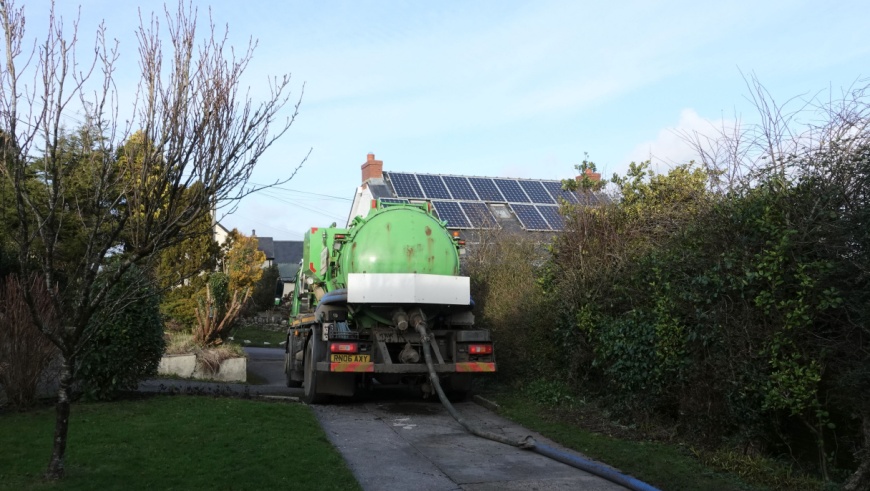
How Much to Empty a Septic Tank?
People living in the city or suburban areas tend to take sewer systems for granted, but if you live in a rural location, then you will realise the importance of septic tanks.
If there is no mains sewer system, homes will require a septic tank for baths, toilets, and dishwashers to drain into. These tanks need to be emptied around once a year.
A septic tank emptying contractor will be supplying their own specialist equipment to empty the tank and dispose of the contents safely.
They will usually charge around £100 to £300 per emptying depending on the size and time it takes to clean. Subject to the size of the tank, this will usually only need to be done once a year.
Table of Contents
- How much to empty a septic tank?
- Additional septic tank emptying costs
- How much does septic tank emptying cost near me?
- What factors impact the cost of emptying a septic tank?
- What does emptying a septic tank involve?
- Emptying your own septic tank
- Types of septic tank
- When should I empty my septic tank?
- Septic tank regulations
- FAQs
- How to find and hire a septic tank specialist
- Sources
Septic Tank Emptying Prices
| SEPTIC TANK SIZE | AVERAGE COST | DURATION |
|---|---|---|
| Small | £100 | 30 - 45 minutes |
| Medium | £150 | 1 hour |
| Large | £200 | 1 - 2 hours |
| Extra Large | £300 | 2 - 3 hours |
In the below table, you'll find the average cost of emptying septic tanks depending on their size and type:
| VOLUME | GLASS-REINFORCED SEPTIC TANK | BRICK OR MASONRY SEPTIC TANK |
|---|---|---|
| 3000 litres | £130 | £150 |
| 4500 litres | £200 | £230 |
| 5000 litres | £220 | £250 |
| 6000 litres | £265 | £300 |
Additional Septic Tank Emptying Costs
As part of a regular maintenance system for your septic tank, you should monitor what is going into it via your drains.
It can be easy to thoughtlessly discard items down the plughole of your sink or into the toilet, especially if you have been used to the convenience of mains drainage. With a septic tank, this may have more expensive implications than simply finding out the cost of unblocking a toilet and hiring someone to do that.
Owning a property with a septic tank for waste management takes a bit of getting used to in regard to your mindset and habits.
Not only what you dispose of down the drains but also what cleaning products you use.
Septic Tank Maintenance Costs
For a septic tank bleach is a definite no-no as are any anti-bacterial products such as handwash and wipes.
Getting used to checking the detergents and cleaning agents before you buy them takes a while but is definitely worth doing to avoid creating problems with your septic tank.
The environment inside the septic tank depends on the anaerobic bacteria within it to break down the solid waste as much as possible. Therefore, it is important that you do not add anything to the septic tank that would disrupt this balance.
Some of the products you now need to consider buying for your home may be slightly more expensive than what you used to buy but should be viewed as integral to the health of the property's waste management system.
Drain Unblocking Costs
Keeping the drains clear is important so you may consider jet washing to ensure that there is no build of material to stop the flow of water reaching the septic tank.
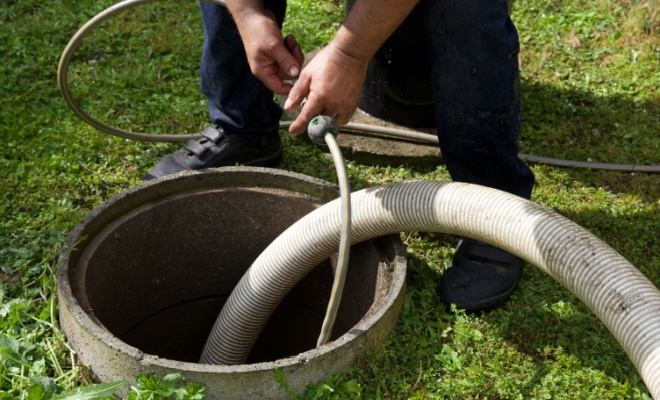
The average drain jetting cost will be around £250 to £300 per day.
CCTV Inspection Costs
CCTV inspection can be used to carry out a detailed examination of the drains if you suspect there is a serious issue.
This can help to prevent a minor issue escalating and developing into a major and potentially expensive problem.
The average cost of a CCTV inspection of drains is between £100 and £300 depending on how detailed the survey is.
Septic Tank Emptying Cost Breakdown Calculator
Individual costs of cleaning a large septic tank - Total Cost: £200
Materials
£0
Tradesmen
£50
Waste Removal
£150
How Much Does Septic Tank Emptying Cost Near Me?
The septic tank emptying cost charged by most waste management is based on the volume of the septic tanks, whether that is in gallons or litres.
It can also be based on the kind of septic tank being emptied such as the modern polyethylene or the traditional masonry tanks, and the amount of time and effort required to empty it.
Labour Cost
The average cost to empty a septic tank will include the cost of labour.
The extent of the labour cost will be dependent on the size of the tank, the location of the property and the ease of access for the machinery.
The tank operator is responsible for driving the vehicle, operating the machinery, including the vacuum that removes the sludge from the tank and taking it to a sewage treatment facility.
How to Reduce Septic Tank Emptying Costs
To ensure that the septic tank functions properly and breaks down the waste entering it, a good bacterial balance is essential.
Harsh chemicals such as bleach should never be put into the septic tank as they will destroy the anaerobic bacteria as will anti-bacterial soaps and liquids.
Dishwasher tablets can contain phosphates which are harmful to the beneficial bacteria in the tank so low or no phosphate detergents are best.
Using detergents with low phosphate will help to maintain the good bacterial levels in the tank to aid decomposition of the solid matter and prevent the drainage field from being overloaded with suspended solids.
This should mean that the environment inside the septic tank is optimum for breaking down the solid matter, and this should mean that the sludge will not build up quickly.
In turn, this means that emptying will need to be done less often and will reduce the maintenance cost of the septic tank.
How Long Does Septic Tank Emptying Take?
The length of time taken to empty a septic tank will be determined by a number of things; the volume of the tank (i.e. the amount of waste it holds), the access to the tank from the highway, and also the experience of the tank operator.
On average it should take no more than a couple of hours to empty an average-sized septic tank.
A large tank will take longer to empty than a smaller one due to the amount of waste involved, but some smaller tanks may have become blocked or overfilled and therefore take some time to empty.

An experienced tank operator will have knowledge of different types of septic tanks and will be confident in driving and operating the machinery on the tanker.
This should mean that the operation is carried out quickly and efficiently. If the operator is new or relatively inexperienced, then the process may be a little slower.
They may not be as familiar with the equipment or as confident in manoeuvring the vehicle as more veteran operators.
As long as the tank emptying is carried out properly and you are not expected to pay for a slightly longer operation, then it should not present a problem.
Access to the Septic Tank
There must be clear and unobstructed access to the septic tank for emptying.
Septic tanks should be installed within 30 metres of an access point, so there should not be an issue with distance unless the septic tank has been in situ for a long time and before these guidelines came into existence.
However, effective communication with your waste management company is crucial to avoid delays and ensure the costs of emptying a septic tank do not rise.
This should hopefully avoid an unsuitable vehicle being despatched to empty your tank only to find it is too wide for the road or too heavy for a weight-restricted bridge.
A lack of preparation for the arrival of the emptying tanker such as arranging for a parking permit or not advising of narrow or low access may have an adverse effect on how much you pay for the service.
Some waste removal contractors may not wait if they have other clients booked, and it may be necessary to re-book.
This could cost a lot as the contractor may charge for a failed visit, and you then need to pay for a second booking.
Additional Issues
If it comes to light that there is an issue with the tank itself perhaps that it has not been emptied in a very long time or there is material in the tank that should not be there, then the emptying process may take longer than normal.
Items such as sanitary products or cat litter are often flushed down the drains and cause serious blockages.
These items will not biodegrade and will fill up the septic tank much quicker, resulting in more frequent emptying being needed.
What Factors Impact the Cost of Emptying a Septic Tank?
Here are some factors that can affect the overall cost of emptying septic tanks:
Size of the Septic Tank
The size of the septic tank will determine how long it takes to empty, and this may affect the cost.
Some companies charge per 1000 gallons for emptying while others will have a set price for a specific type of tank.
This is worth bearing in mind if you're looking at the cost of a new septic tank, yet remember that the tank must have adequate capacity for all a household's wastewater needs, not just the toilet and bathroom.
Smaller septic tanks are cheaper to buy and install, yet they may require emptying more often. This can be expensive over the tank's lifetime.
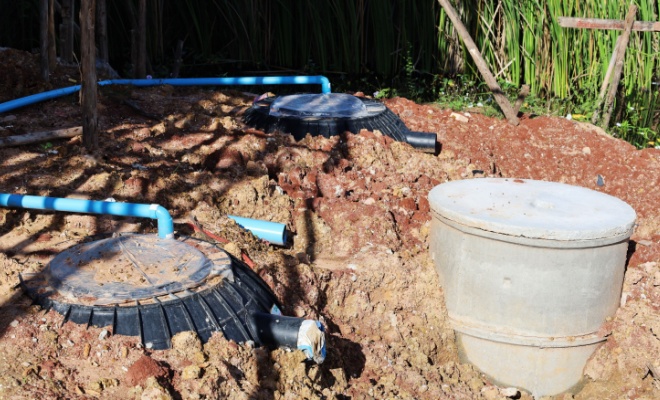
Larger tanks cost more to buy and install but are generally cheaper over the long term when maintained correctly.
The other benefit of a large septic tank is that a soakaway can be used for some of the wastewater to be filtered out, so the tank can be emptied less often.
The costs of installing a soakaway can be around £700 to £1,000, depending on where you're hoping to install it.
As long as septic tanks are emptied regularly and have been installed properly in the first place, they are largely problem-free.
The size of the tank will have an impact on the cost of emptying it with the larger tanks costing between £250 and £300, more than doubling the septic tank pumping cost in some cases.
Type of Septic Tank
The two most prevalent types of septic tanks in the UK are cylindrical and round or 'onion' shaped.
They are constructed from glass-reinforced plastic or polyethylene and generally have two chambers.
The average cost to empty one of these more modern tanks is £200.
Older types of septic tanks can be made from masonry or brick.
These have either two or three chambers which facilitate the filtering process of the waste and are usually rectangular in shape.
Older septic tanks cost on average £230 to empty.
All septic tanks, new and old, need the addition of a drainage field for the wastewater to percolate through to the soil.
Location in the UK
The location of the property in the UK will have an effect on the septic tank emptying cost, although few properties in London will require this service due to the prevalence of mains drainage.
However, in the South East, there are still rural properties which have septic tanks, and the cost to empty septic tanks in this part of the UK may be higher due to the higher cost of living.
Many properties which rely on septic tanks for household waste management are located in rural areas.
This can be a challenge for access in some instances with narrow lanes, remote locations, weight restrictions, and off-road sites.
Extra charges may be incurred for septic tank emptying in particularly rural or hard-to-reach locations.
What Does Emptying a Septic Tank Involve?
As a general rule, a septic tank should be emptied every twelve months, but this does depend on the size of the tank and the number of people living in a property.
For more people in a small to medium household, then annual emptying is advisable whereas fewer people in a large property may mean this can be done every 2 years.
Emptying a Septic Tank
There will be signs if a septic tank is full and struggling to cope with the waste being deposited.
Toilets will be slower to flush, drains may take longer to empty, or you may notice a bad smell coming from the area of the septic tank or drainage field.
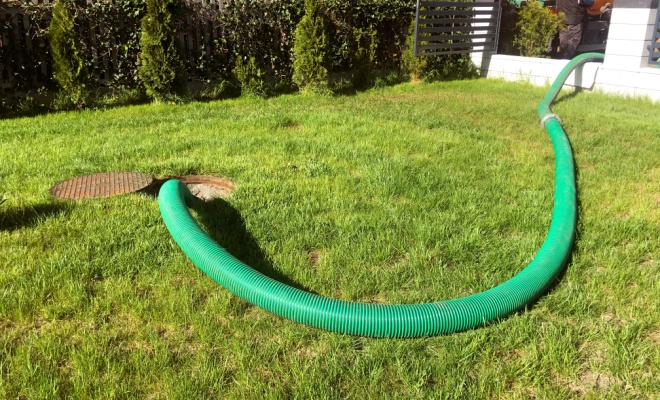
All of these signs point to a waste system that is struggling, and this needs to be addressed quickly to avoid or mitigate damage to the tank or the drainage field.
If left unchecked then the damage could be irreparable, and the drainage field could become unusable, and if you have no other ground to locate a new drainage field too, this will present you with a significant problem to fix.
- There are 3 layers of waste within the septic tank.
- The top layer is all the fat, grease and lighter materials which form a type of crust on the surface of the water in the septic tank.
- The middle is mostly the wastewater with some suspended solids within it. This is what passes through the tank into the drainage field, which is a system of perforated pipes which are laid in the ground. The wastewater percolates into the soil through these pipes.
- The bottom layer is where debris has settled and built up over time; this is commonly called sludge. This layer and the top layer are what should be removed when your septic tank is emptied.
- A tanker will arrive and lower a suction pipe into the septic tank.
- The sludge at the bottom of the tank will be sucked into the tank on the vehicle.
- The layer at the top of the tank, the crust, should also be removed. The only element remaining should be wastewater.
- The removed waste is then taken to a treatment works where it is sterilised and discharged in a controlled way.
Most contractors will need to drive a tanker onto your property so they will need unobstructed access between the septic tank and the parking area.
The de-sludging or emptying service offered to customers with septic tanks usually includes the removal and treatment of around 1000 gallons of sludge.
As part of the emptying process, the tank is also normally 'backwashed' to remove any solid waste.
This emptying service can be done as a one-off or more often as part of a regular maintenance contract.
Emptying Your Own Septic Tank
Emptying a septic tank is not recommended as a DIY job.
Due to the nature of the work and the waste involved, it is strictly regulated and must conform to the law on pollution and water safety.
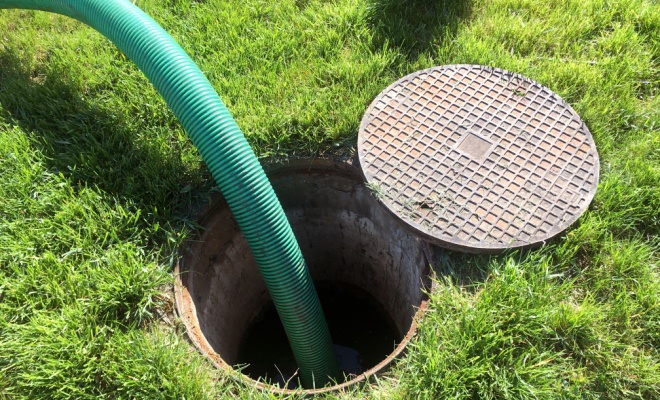
Licensed waste disposal contractors are permitted to empty a septic tank, and have the expertise to do this safely. The waste has to be removed to a waste treatment plant and properly sterilised and discharged.
How Can You Lower the Cost of Emptying a Septic Tank?
Make sure access to the site is adequate and without obstruction. Informing the waste contractor of any restrictions on access is necessary to avoid being charged for a failed visit.
If there are narrow country lanes or difficult terrain to be negotiated, it is important to let them know in advance so that the appropriate vehicle can be delegated to the job.
Some companies have mini tankers for tight spaces, and others have towable tankers that can be pulled by a 4x4 vehicle for tricky ground.
However if you don't let them know in advance, your waste contractor could turn up in a large, multi-ton truck and if it cannot gain entry to the site, then you may be charged for a failed visit and pay for a different vehicle to attend your property.
Types of Septic Tank
Older septic tanks were normally brick-built rectangular receptacles with two or three chambers to filter the waste.
These days septic tanks are made from glass reinforced plastic or polyethylene and can be either rectangular, cylindrical, or round 'onion' shaped.
The cost of installing a septic tank if you need a new one is usually between £1,500 and £2,000.
Cylindrical Septic Tank Emptying Cost
Cylindrical tanks are designed for shallow installation, which means that it is not necessary to excavate a large hole to insert them.
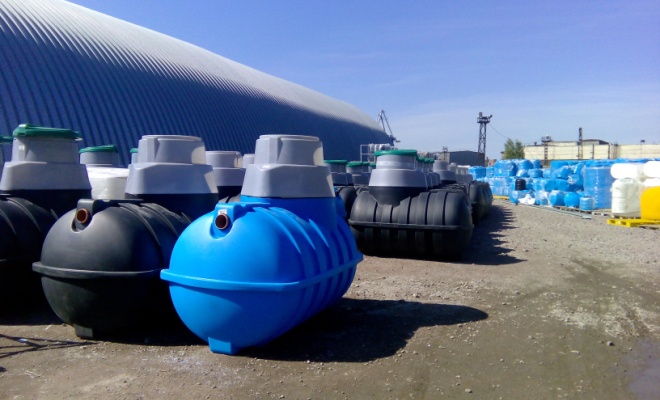
They normally consist of two chambers with an inspection/access hatch above ground for each chamber.
Pros of cylindrical septic tanks:
- ✔ Suitable for shallow installations
- ✔ Requires less backfill for stabilisation than round tanks when installed
- ✔ Produce cleaner effluent than round tanks
Cons of cylindrical septic tanks:
- ✖ Need more lateral space for installation than round tanks
- ✖ More expensive than round septic tanks
- ✖ Usually have 2 access hatches displayed above ground
Cost of cylindrical septic tanks: the average cost of a 2800 litre cylindrical septic tank is £950.
Round Septic Tank Emptying Cost
Round septic tanks are sometimes referred to as 'onion' tanks due to their bulbous shape and extended neck to the access hatch.
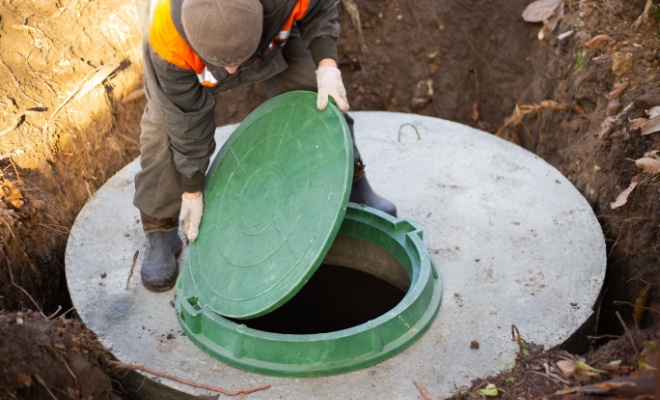
The flow inside this type of tank is upward as opposed to lateral in a cylindrical tank.
Pros of round septic tanks:
- ✔ Fit into smaller spaces than cylindrical tanks
- ✔ Made from heavy-duty material
- ✔ Suitable for most ground conditions
Cons of round septic tanks:
- ✖ Need a deep site for installation
- ✖ Less choice of size than cylindrical tanks
- ✖ Excavation costs for installation will be higher
Cost of round septic tanks: the average cost of a 2800 litre round septic tank is approximately £600.
Glass Reinforced Plastic Septic Tank Emptying Cost
Glass-reinforced plastic is a light but strong material which has largely replaced concrete in septic tank construction.
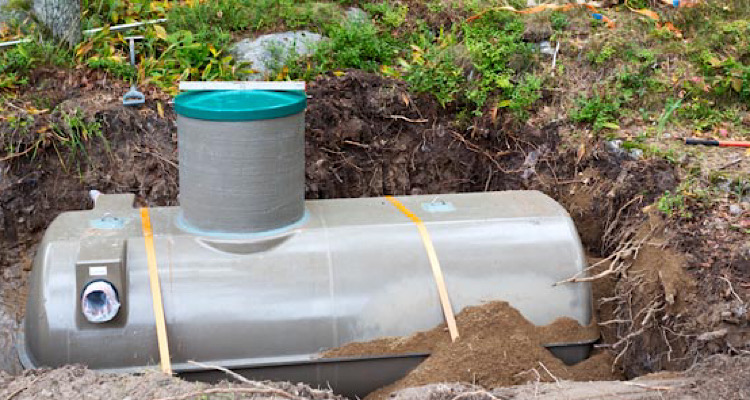
It is watertight and chemically resistant, making it ideal for this purpose.
Pros of glass-reinforced plastic septic tanks:
- ✔ Durable and light
- ✔ Strong and resistant to cracking
- ✔ Good chemical resistance
Cons of glass-reinforced plastic septic tanks:
- ✖ May move if the water table rises
- ✖ Heavyweight on top such as vehicles can damage them
- ✖ Can be susceptible to cracking under stress
Cost of glass-reinforced plastic septic tanks: the average cost of a 3800-litre glass-reinforced plastic septic tank is £,1100.
Concrete Septic Tank Emptying Cost
Concrete is a very versatile and widely used material in all types of construction and septic tanks are no exception and were among some of the very first septic tanks installed in the UK.
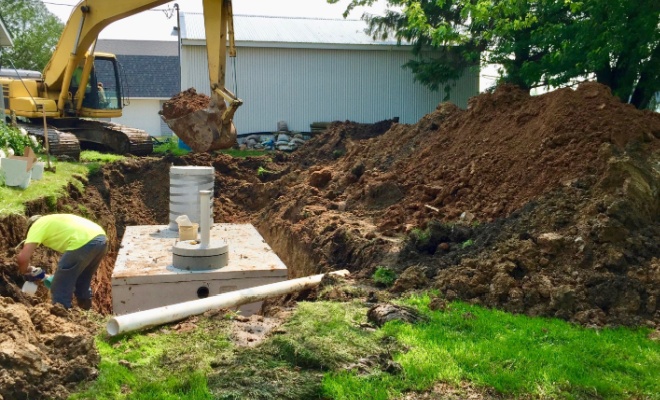
Pros of concrete septic tanks:
- ✔ Heavy so will not be lifted by rising groundwater
- ✔ Long-lasting material
- ✔ Very strong and durable
Cons of concrete septic tanks:
- ✖ Installation is more labour intensive
- ✖ Damage is difficult to repair
- ✖ Expensive compared to alternatives
Although it may be possible to buy a bespoke pre-cast concrete septic tank, the most common concrete domestic sewage management systems are now waste treatment plants. These are more environmentally friendly as they produce much cleaner waste.
This is reflected in the price although they do have a longer service life than an average septic tank.
The average cost of a pre-cast concrete treatment plant is around £5,000.
When Should I Empty My Septic Tank?
Septic tanks use an inlet pipe that comes from the property into the tank and an outlet pipe that runs into a drainage field.
A drainage field is a network of perforated or slotted pipes which allow the wastewater to percolate slowly into the ground without causing pollution.
This process further filters the wastewater removing more bacteria and solid elements from it.
Frequency of Emptying
The septic tank separates out the waste into 'scum', 'separated waste-water' and 'sludge'.
It is the separated wastewater which runs into the soak-away system; the more solid yucky stuff stays in the tank, which is why septic tanks need to be emptied out on a regular basis.
If you do not empty your septic tank regularly, then toilets will start taking longer to flush, and you may even get smelly waste backing up to your home.
The wrong kind of waste can then get into the soak-away system and begin pooling above ground; this creates an awful smell and can even pollute local water sources.
At least once a year you should have your septic tank emptied if only to maintain the system in good working order.
Large tanks may not fill up, but it is good practice to empty them regularly to ensure that the tank is working effectively.
A small, crowded property with a septic tank will put pressure on the system, and the tank may need to be emptied on a more frequent basis, e.g. every six months.
This can happen if you have put an extension on a property with a septic tank without replacing the tank to allow for the added usage.
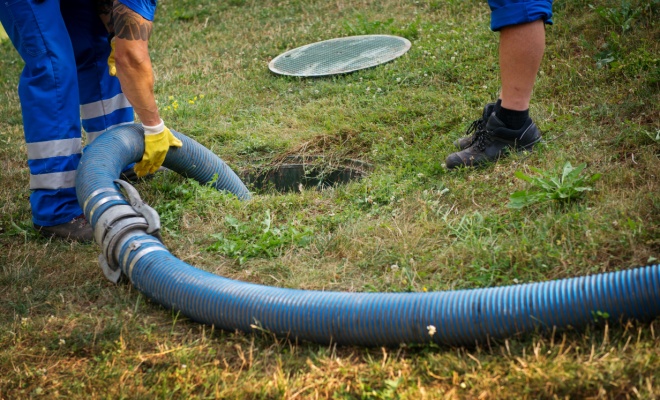
The size of the septic tank will dictate how much waste it can hold, but the rate at which it fills will be determined by the number of people in the household.
Obviously, the more people in the house, the more waste will be produced; therefore, the septic tank will need to be emptied more often.
An allowance of 180 litres per person per day is used to calculate the size of the septic tank that a property would require so this represents the capacity of the tank in relation to how frequently it needs to be emptied based on the occupancy of the property.
Septic Tank Regulations
The responsibility for a septic tank on your property and the waste it contains is explained in the General Binding Rules. Changes from 1 January 2020 relate to the disposal of waste into a watercourse.
As of that date, any septic tank that discharges into a ditch, stream or river will need to be replaced with a waste treatment system or the waste must be diverted to a drainage field.
A property that has a septic tank discharging into a watercourse cannot be sold without the upgrade to a waste treatment system or the addition of a drainage field. This is the sole responsibility of the owner and at their cost.
The Environment Agency is responsible for the regulation of septic tanks and can impose fines if they are not compliant and pose a potential pollution threat.
The fine for failing to comply with these regulations and potentially polluting a water source can be up to £100,000.
FAQs
An anaerobic bacterial environment inside the septic tank means that the waste is broken down in a biological process. This encourages decomposition and mineralisation of the waste products.
Obviously, things like nappies, wipes and cat litter should never be flushed down the toilet whether you have a septic tank or mains drainage as they can block the drains.
It is also possible to buy sachets containing microorganisms, bacteria, and enzymes to help maintain the anaerobic environment. These are put down the toilet either weekly or monthly, depending on their strength.
A visual check by lifting the septic tank cover will tell you if there is a blockage which can be physically rectified or if the tank is full and needs to be emptied.
Always exercise caution around a septic tank as the fumes can be very strong, especially if it is not functioning properly or overfilled. Children and pets should be kept away from the area while you are checking.
In the UK you may need to go to a specialist shop for these as septic tanks are not as common as in countries like Ireland or France.
A cesspit is a sealed underground tank that collects sewage and wastewater. It has no treatment process for the waste and has access via a manhole cover to allow for emptying.
How to Find and Hire a Septic Tank Specialist
It's best practice to hire a licensed professional to emppty your septic tank.
While it's theoretically possible to empty it yourself, there are regulations involved that make it far easier to hire someone else.
For example, waste from your septic tank will need to be disposed of properly and conform to any relevant environmental regulations. It should also be disposed of at a licenced waste facility and transported by someone licensed to do so.
It's most likely you will hire a waste management company or specialist drainage company to empty your septic tank. However, there may be local options such as licensed agricultural contractors who use their equipment to serve domestic septic tanks.
Many waste management companies will offer the same services as specialist drainage companies. However, as the name suggests, specialists in drainage will have more experience with septic tanks and probably deal with them very regularly.
When choosing a company to empty your septic tank, consider the following points:
- They must be licensed to carry out the job.
- They must take the waste to a sewage treatment works.
- They should have appropriate insurance and liability cover.
- They will have an environmental permit to undertake the work.
Reputable companies will have no problem providing this evidence, ensuring that you're working with a company who will act responsibly throughout the process.
Remember, septic tank emptying costs will be exponentially increased if you don't follow the proper process and dispose of septic waste incorrectly.
Cost of Hiring a Septic Tank Emptying Company
The average cost to hire a waste management company to empty your septic tank is approximately £200.
Regional variations may apply, and there are slight differences between prices for emptying a glass-reinforced plastic septic tank and a brick or masonry built one.
The septic tank emptying cost will be affected by its size. In turn, the number of people living at a property will affect how often the tank needs to be emptied.
Who Can Empty a Septic Tank?
Registered waste disposal contractors are licensed to carry out the emptying of a septic tank. It's typical for property owners to employ such a company to empty their tanks regularly.
It is a good idea to use a company that has been established for some time so that you know that they are reputable and will have experienced staff.
Contractors who have the correct licencing will be listed on the official Register of Waste Carriers, Brokers and Dealers. Always check that the company you are using is on the register.
Sources
https://environment.data.gov.uk/public-register/view/search-waste-carriers-brokers
https://assets.publishing.service.gov.uk/government/uploads/system/uploads/attachment_data/file/442889/BR_PDF_AD_H_2015.pdf
https://www.gov.uk/government/publications/small-sewage-discharges-in-england-the-general-binding-rules
https://www.gov.uk/guidance/general-binding-rules-small-sewage-discharge-to-the-ground
https://www.crystaltanks.com/tank_emptying.html






